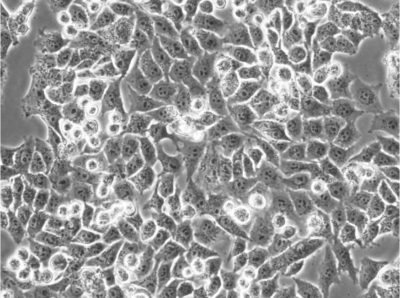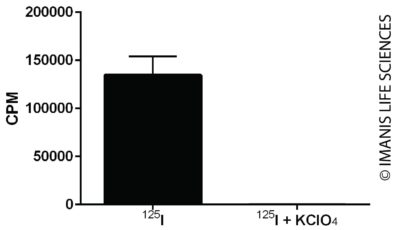A375-hNIS-Puro
| Species | Human |
| Cell Type | Melanoma |
| Transgene | Human sodium iodide symporter (hNIS) |
| Selection Gene | Puromycin resistance (Puro) |
-
Description
A375-hNIS-Puro is a polyclonal population of the human malignant melanoma cell line A375 (ATCC® CRL-1619™). To achieve stable reporter expression in the polyclonal population, parental A375 cells were transduced with LV-humanNIS-P2A-Puro (LV019) and selected using puromycin. LV-humanNIS-P2A-Puro encodes the human sodium iodide symporter (hNIS) cDNA linked to the puromycin resistance gene (Puro) via a P2A cleavage peptide under the spleen focus-forming virus (SFFV) promoter.
*The ATCC trademark and trade name and any and all ATCC catalog numbers are trademarks of the American Type Culture Collection.
This cell line has been tested for mycoplasma contamination and is certified mycoplasma free.
The parental A375 cell line has been authenticated and certified free of interspecies cross contamination by short tandem repeat (STR) profiling with 9 STR loci.
Replication Competent Lentivirus (RCL) Test (including a test report) is available for this cell line at an added cost. Contact us to learn more.
-
Characterization
Morphology
 Cell photos taken at 200x magnification.
Cell photos taken at 200x magnification.NIS Expression

Cells were incubated with I-125 for one hour in the presence or absence of KClO4, an inhibitor of NIS-mediated iodine uptake. Radioiodine concentrated within the cells was measured with a gamma counter.
-
Growth Conditions
Complete Growth Medium: DMEM supplemented with 10% FBS, 1X Penicillin/Streptomycin, and 1 µg/mL puromycin.
The addition of puromycin to the complete growth medium maintains high reporter expression over continued passage of the cells. It is highly recommended, especially if the cells undergo multiple passages prior to being used for studies.
These cells should be grown in the indicated medium and passaged when they reach confluency. For routine passaging, cells are recommended to be split at a 1:10 ratio every 3-4 days.
-
Usage Information
These cells are suitable for in vitro and in vivo experimentation. A375 cells are a xenograft model for malignant melanoma and form tumors post-implantation into immunosuppressed mice.1 The NIS transgene facilitates high resolution, 3D SPECT/PET imaging of implanted cells. NIS is not immunogenic and is therefore suitable for longitudinal imaging studies.
The cells can be amplified in vitro and used to generate additional frozen stocks. Cryopreservation of low passage stocks is recommended. Frozen stocks should be preserved in a designated cryopreservation medium.
These cells were generated via lentiviral vector transduction. The lentiviral vector used for transduction was a self-inactivating (SIN) vector in which the viral enhancer and promoter have been deleted. Transcription inactivation of the LTR in the SIN provirus increases biosafety by preventing mobilization by replication competent viruses and enables regulated expression of the genes from the internal promoters without cis-acting effects of the LTR2. Nevertheless, all work with these cells should be performed under biosafety-level 2 (BSL2) conditions by trained personnel. Institutional requirements may permit handling of these cells under BSL1 conditions if certain criteria are met.
References:
1Gershwin et al. J Natl Cancer Inst 1977. 58:1455-1461.
2Miyoshi et al. J Virol 1998. 72:8150-8157. -
Datasheet/COA
Lot Number CL-IM42